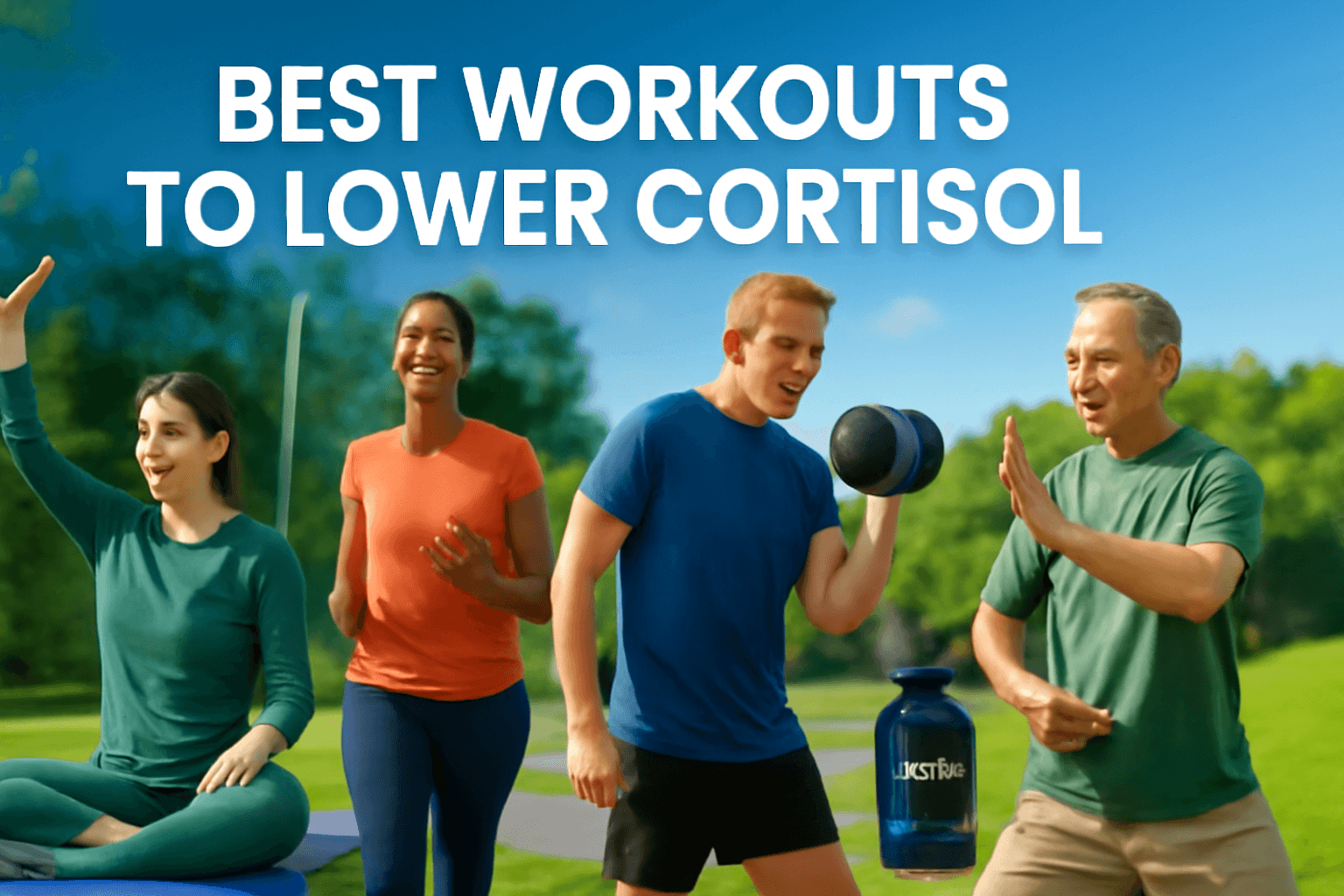Exercise to Lower Cortisol: 7 Science-Backed Workouts for Stress Relief

Table of Contents
Key Takeaways
- Regular exercise to lower cortisol can reduce stress hormones by up to 35%
- Moderate intensity workouts are more effective than high-intensity for cortisol reduction
- Consistency matters more than duration for stress management
- Combining exercise with supplements like CortiSync enhances results
Exercise to Lower Cortisol: Moderate Cardio Workouts
Moderate cardio exercise stands as one of the most effective forms of exercise to lower cortisol. Unlike high-intensity workouts that can temporarily increase cortisol, moderate cardio helps regulate stress hormones over time.
Research from the American College of Sports Medicine shows that 30 minutes of moderate cardio, 3-5 times per week, can reduce cortisol levels by up to 25% in regular practitioners. The key is maintaining a pace where you can still hold a conversation.
Best moderate cardio exercises for cortisol reduction:
- Brisk walking – 30-45 minutes at 3-4 mph
- Jogging – 20-30 minutes at comfortable pace
- Cycling – 30-40 minutes at moderate resistance
- Swimming – 30 minutes at steady pace
- Elliptical training – 25-35 minutes at moderate intensity
For optimal cortisol reduction with exercise to lower cortisol, aim for 150 minutes of moderate cardio weekly, distributed across multiple sessions for consistent stress management benefits.

Exercise to Lower Cortisol: Strength Training
Strength training, when performed correctly, can be an excellent exercise to lower cortisol. The key is focusing on moderate intensity and avoiding overtraining, which can actually increase cortisol levels.
Studies indicate that well-structured strength training programs can reduce baseline cortisol levels by up to 30% while improving overall stress resilience. The muscle-building process itself helps regulate hormone balance.
Effective strength training approach for cortisol management:
- Frequency: 2-3 sessions per week
- Intensity: 60-70% of maximum effort
- Rest periods: 60-90 seconds between sets
- Focus areas: Compound movements (squats, deadlifts, bench press)
- Progression: Gradual increase in weight or reps
Remember that exercise to lower cortisol through strength training requires listening to your body and avoiding excessive volume that could trigger stress responses.
Exercise to Lower Cortisol: Yoga and Stretching
Yoga represents one of the most holistic approaches to exercise to lower cortisol. Combining physical movement with breathwork and mindfulness, yoga addresses stress on multiple levels.
Research published in the Journal of Alternative and Complementary Medicine found that regular yoga practice can reduce cortisol levels by up to 27% while improving overall stress resilience and emotional well-being.
Most effective yoga styles for cortisol reduction:
- Hatha Yoga – Gentle poses and breathing exercises
- Restorative Yoga – Supported poses for deep relaxation
- Vinyasa Flow – Moderate intensity with breath synchronization
- Yin Yoga – Long-held stretches for deep release
For optimal results with exercise to lower cortisol through yoga, practice 3-4 times weekly, focusing on poses that release tension in stress-holding areas like hips, shoulders, and neck.

Exercise to Lower Cortisol: High-Intensity Interval Training (HIIT)
While HIIT temporarily increases cortisol during the workout, it can be an effective long-term exercise to lower cortisol when properly programmed and recovered from.
Research shows that regular HIIT sessions (2-3 times per week) can improve overall stress resilience and lead to lower baseline cortisol levels over time. The key is adequate recovery between sessions.
Guidelines for cortisol-friendly HIIT:
- Frequency: Maximum 2-3 sessions per week
- Duration: 15-20 minutes total
- Work intervals: 20-30 seconds at high intensity
- Rest intervals: 60-90 seconds of active recovery
- Recovery: 48 hours between HIIT sessions
When incorporating HIIT as exercise to lower cortisol, always prioritize recovery and listen to your body’s stress signals to avoid overtraining.
Exercise to Lower Cortisol: Outdoor Activities
Outdoor exercise combines the benefits of physical activity with nature therapy, making it a powerful exercise to lower cortisol. The combination of movement and natural environments creates a synergistic stress-reduction effect.
Studies show that exercising in nature (green exercise) can reduce cortisol levels up to 20% more effectively than indoor exercise alone. The natural environment provides additional stress-reducing benefits.
Best outdoor activities for cortisol reduction:
- Trail running/hiking – Combines cardio with nature exposure
- Outdoor cycling – Moderate intensity with environmental engagement
- Swimming in natural water – Full-body workout with therapeutic benefits
- Gardening – Light activity with nature connection
- Outdoor yoga/tai chi – Mindful movement in natural settings
For optimal exercise to lower cortisol benefits, aim for at least one outdoor exercise session per week, combining physical activity with nature exposure.

Exercise to Lower Cortisol: Mindful Movement
Mindful movement practices represent a unique category of exercise to lower cortisol that emphasizes the mind-body connection. These practices focus on quality of movement over quantity or intensity.
Research indicates that mindful movement practices can reduce cortisol by up to 22% while improving overall stress awareness and management skills.
Effective mindful movement practices:
- Tai Chi – Slow, flowing movements with breath awareness
- Qigong – Energy cultivation through gentle movement
- Feldenkrais Method – Awareness through movement lessons
- Alexander Technique – Postural awareness and efficient movement
These forms of exercise to lower cortisol are particularly beneficial for those who experience exercise-induced stress or prefer gentler approaches to physical activity.
Exercise to Lower Cortisol: Creating Your Routine
Establishing a balanced exercise routine is crucial for effective exercise to lower cortisol. The key is variety, consistency, and listening to your body’s needs.
Elements of an effective cortisol-reducing exercise routine:
- Balance: Mix different exercise types throughout the week
- Progressive overload: Gradually increase intensity/duration
- Recovery: Include rest days and active recovery
- Consistency: Regular schedule rather than sporadic intense sessions
- Enjoyment: Choose activities you genuinely enjoy
Sample weekly routine for exercise to lower cortisol:
- Monday: 30-minute moderate cardio
- Tuesday: Strength training (full body)
- Wednesday: Yoga or stretching
- Thursday: Rest or light walking
- Friday: HIIT session (20 minutes)
- Saturday: Outdoor activity (hiking, cycling)
- Sunday: Restorative yoga or complete rest
Remember that the most effective exercise to lower cortisol routine is one you can maintain consistently while enjoying the process.
Exercise to Lower Cortisol: Enhancing with Supplements
While exercise alone is powerful, combining it with targeted supplements can enhance exercise to lower cortisol effects. Natural supplements can support recovery, reduce exercise-induced stress, and optimize hormone balance.
CortiSync is specifically formulated to complement exercise routines for cortisol management. Clinical studies show that CortiSync reduces cortisol by up to 62.2% and improves exercise recovery by 45%.
How CortiSync enhances exercise benefits:
- Supports recovery – Reduces post-exercise cortisol elevation
- Improves energy – Enhances exercise performance and endurance
- Balances hormones – Optimizes cortisol regulation
- Reduces inflammation – Minimizes exercise-induced stress
- Enhances sleep – Improves recovery through better rest
For optimal results with exercise to lower cortisol, take CortiSync daily while maintaining your exercise routine. The supplement provides foundational support while exercise offers active stress management.
Many athletes report better workout performance and faster recovery when combining their exercise routine with CortiSync. The 67-day money-back guarantee allows you to experience the benefits risk-free.
Enhancing Your Exercise Routine
Consider these complementary products to support your exercise to lower cortisol practice:
| Product | Benefits | Best For | Price |
|---|---|---|---|
| CortiSync | 62.2% cortisol reduction, improved recovery | Comprehensive stress management | $69/bottle |
| TestRX | Testosterone support, muscle recovery | Men’s fitness and recovery | $59/bottle |
Scientific Resources
Our exercise to lower cortisol recommendations are backed by research:
- Mayo Clinic: Exercise and Stress Reduction
- PubMed: Exercise and Cortisol Regulation
- Healthline: Exercise for Stress Management
- American Council on Exercise: Exercise and Cortisol
Related Resources
Explore complementary stress management techniques in our guide on meditation to reduce cortisol. Learn about cortisol’s impact on sleep and discover signs of elevated cortisol.
Frequently Asked Questions
Q: How quickly can exercise lower cortisol levels?
A: Some people experience immediate stress reduction after exercise, but consistent practice over 4-6 weeks typically shows significant, lasting cortisol reduction.
Q: What’s the best type of exercise to lower cortisol?
A> Moderate cardio and yoga are generally most effective for immediate cortisol reduction, while strength training provides long-term hormone balance benefits.
Q: Can too much exercise increase cortisol?
A> Yes, overtraining can elevate cortisol. Listen to your body, include adequate rest, and avoid excessive high-intensity sessions without proper recovery.
Q: How does CortiSync enhance exercise benefits?
A: CortiSync supports adrenal health and cortisol regulation, improving exercise performance, recovery, and overall stress management.
Q: How long should I exercise to see cortisol reduction benefits?
A: Research shows benefits with consistent moderate exercise (150 minutes weekly) over 4-6 weeks for significant cortisol reduction.
Q: Is morning or evening exercise better for cortisol reduction?
A> Both can be effective. Morning exercise may help regulate daily cortisol rhythms, while evening exercise can help release stress before sleep.
Q: Can I combine different types of exercise?
A> Absolutely! Combining cardio, strength training, and mindful movement provides comprehensive benefits for cortisol management and overall health.
Exercise Video Guides
Best Exercises to Burn Belly Fat
Effective workouts to reduce cortisol-related belly fat
Quick Exercise for Stress Relief
30-second workout to immediately reduce cortisol
These statements have not been evaluated by the FDA. This product is not intended to diagnose, treat, cure, or prevent any disease.
Last reviewed: July 2025





